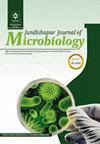Clostridium difficile Infection Risk Factors and Outcomes Among Inpatients Infected with NAP1/BI/027 Strain Compared to Non-NAP1 Strain in a Major Chinese Hospital
IF 0.5
4区 医学
Q4 MICROBIOLOGY
引用次数: 0
Abstract
Background: NAP1/027 Clostridium difficile infection (CDI) has rarely been reported in China. Objectives: The objective of this study was to strengthen the understanding of the risk factors and outcomes of NAP1/027 CDI. Methods: A single-center, retrospective, case-control (1: 3) study was performed to identify risk factors and outcomes specific to NAP1/027 CDI using a group of patients with NAP1/027 CDI (n = 20) and a group of age-matched control patients with non-NAP1/027 CDI (n = 60) within June 2018 and August 2021. The patient charts were thoroughly reviewed to assess the markers of severity, risk factors, and outcomes. Results: Out of the 272 stool specimens, 41 cases (15.07%) tested positive for the NAP1 strain of C. difficile using the polymerase chain reaction. Among these specimens, 20 cases fulfilled the inclusion criteria. No significant difference was observed between the NAP1/027 and non-NAP1/027 groups in disease severity, length of hospital stay, or mortality. Logistic regression analysis revealed that risk factors for acquiring NAP1/027 infection included hospitalization in the 90 days before CDI diagnosis and high C-reactive protein level within ± 3 days of C. difficile detection. Conclusions: In a large non-epidemic tertiary hospital in China, NAP1/027 strains were more prevalent in patients with previous hospitalization and high CRP level than non-NAP1/027 strains.中国某大医院感染NAP1/BI/027菌株与非NAP1菌株住院患者艰难梭菌感染的危险因素及转归
背景:NAP1/027艰难梭菌感染(Clostridium difficile infection, CDI)在中国报道较少。目的:本研究的目的是加强对NAP1/027 CDI的危险因素和预后的认识。方法:采用2018年6月至2021年8月期间的NAP1/027 CDI患者组(n = 20)和非NAP1/027 CDI对照组(n = 60),进行单中心、回顾性、病例对照(1∶3)研究,以确定NAP1/027 CDI的危险因素和结局。对患者的病历进行全面审查,以评估严重程度、危险因素和结果。结果:272例粪便标本中,艰难梭菌NAP1聚合酶链反应阳性41例(15.07%)。其中20例符合纳入标准。NAP1/027组与非NAP1/027组在疾病严重程度、住院时间或死亡率方面无显著差异。Logistic回归分析显示,发生NAP1/027感染的危险因素包括CDI诊断前90天住院和艰难梭菌检测后±3天内c反应蛋白水平升高。结论:在国内某大型非流行病三级医院中,既往住院且CRP水平高的患者中NAP1/027株比非NAP1/027株更流行。
本文章由计算机程序翻译,如有差异,请以英文原文为准。
求助全文
约1分钟内获得全文
求助全文
来源期刊

Jundishapur Journal of Microbiology
MICROBIOLOGY-
CiteScore
1.30
自引率
0.00%
发文量
56
审稿时长
6-12 weeks
期刊介绍:
Jundishapur Journal of Microbiology, (JJM) is the official scientific Monthly publication of Ahvaz Jundishapur University of Medical Sciences. JJM is dedicated to the publication of manuscripts on topics concerning all aspects of microbiology. The topics include medical, veterinary and environmental microbiology, molecular investigations and infectious diseases. Aspects of immunology and epidemiology of infectious diseases are also considered.
 求助内容:
求助内容: 应助结果提醒方式:
应助结果提醒方式:


